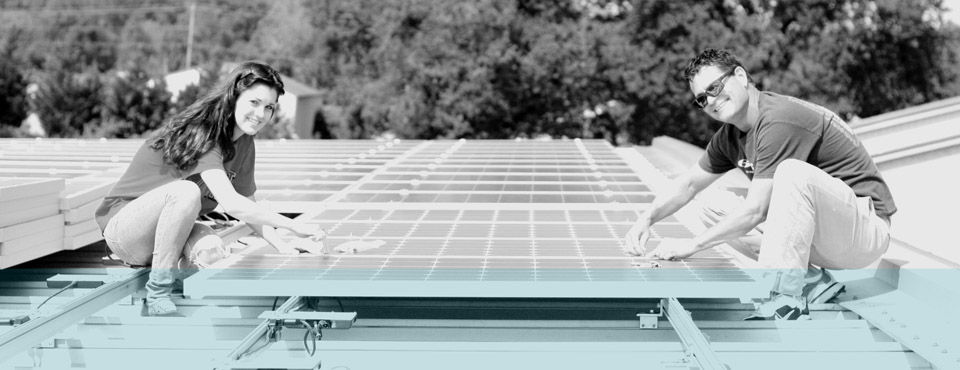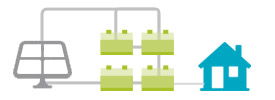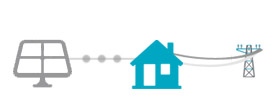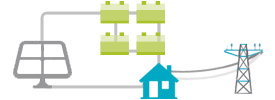System Types

What System Type is Best for You?
Because there have been a lot of questions among potential solar customers about the types of systems that are available, Pickering Energy Solutions has added this section which provides some basic information about the types of systems that are available.
There are generally three types of systems which are available. They are Off-grid systems, Grid-tied systems and Hybrid systems. In the following sections we will explain these systems individually.
1. Off-grid Systems

Off-grid systems, or stand-alone systems, are not intended to interconnect with the electric utility grid system. These are generally found only in buildings or facilities where permanent grid-tied power is not available, either due to cost or other reasons. These systems have solar panels which collect energy as DC power, store this power in battery systems, and provide DC power for general use on the premises. These systems often have inverters to convert the DC voltage to AC voltage for use in general appliances designed for the 120V or 240V AC utility grid. Customized systems are available in different DC and AC voltages and configurations based upon the requirements of the system and user.
Off-grid systems are generally specifically designed for the application—to supply only the loads which the client requires. Designing this system begins with a load study to determine the peak power requirements for the system and interconnected equipment, and usually ends up in a discussion about the most efficient equipment and appliances available for the particular application. Next there is an evaluation of the size of solar PV collection system and the battery system. Because the sun does not always shine uniformly, but we need power all the time, the only place for the power to come from (if not considering stand-by generators) when the sun is not shining is from the battery system. We will have the client determine what the length of the “ride through” period they may need for their battery system (how long they want the battery system to supply their loads without the availability of direct sunlight). This is usually expressed in the number of days without direct sunlight. In the case of the stand-alone systems we have designed and installed in Liberia (see Naama and Botota Clinics in our Portfolio section) we designed the ride-through for six days. Because this system powers refrigeration for expensive vaccinations we have a longer ride-through than might be normally be experienced.
Off-grid systems are among the most expensive systems because they require expensive battery systems to store the energy required for the (often long) ride-through periods. Because batteries have a limited number of charge-discharge cycles available, they require replacement every few years under continuous use. Additionally, different types of batteries have various cost points and other advantages and disadvantages, however overall using current battery technology the storage of power using batteries is still quite expensive, although there are many companies working hard to optimize this power storage process.
2. Grid-tied Systems

Grid-tied systems are the new technology on the market. These systems use the same solar panels as the off-grid systems, creating DC power at the panel. These systems then use various technologies to convert the DC power to AC power and synchronize it with the power that is provided by the electrical utility grid. These systems are designed to be provided on buildings or located on facilities which are grid-connected. Because these systems are grid-tied, the power which is produced is first utilized on the premises, and excess power flows back through the meter and to the utility’s distribution network. These systems operate on a special agreement called “net metering” in most states. In these cases the power company provides a meter and billing which indicates the amount of power provided to the client, the amount of power returned, and a billing for the “net” amount of power provided to the client. This allows power generated on the premises to be utilized to offset the power purchased by the utility.
In this case the utility can be considered the “battery” for the solar power system. The solar power systems produce power when the sun is shining, with the excess power flowing back into the utility’s system. This power can then be utilized when needed from the utility, and the customer is only charged for the difference in power provided less used.
The industry has developed two types of inverters to provide this grid-tied power in an economical manner.
The oldest are the string-inverters, which put the solar panels together in a series of DC “strings”, establishing a DC voltage between 100 and 600 volts. This DC power is then provided to the string inverters, which synchronizes this power with the utility and provides it for use interconnected with the electrical utility equipment. Most string inverters come with a 5 or 10 year warranty.
The newest technology is the micro-inverter technology. In this system there are a series of microinverters mounted underneath the solar panels on the roof or racking. These microinverters take the DC power from a single PV panel, convert it directly into AC power and synchronize with the utility. These microinverter systems can interconnect at various points within the electrical distribution system, although the utility regulations have not caught up with the advantages of this technology. Most of the grid-tied systems in our portfolio utilize the microinverter technology, which allows more flexibility in the installation and better performance. Additionally, Enphase microinverters are warranted against defects for 25 years.
From the perspective of minimizing the equipment cost, getting renewable energy into the market and providing a fast return on the solar PV investment, these systems are optimized to maximize their return and provide long-life. Grid-tied systems are usually designed to offset a certain portion of the utility annual energy use, and often constrained by roof or available space.
The compromise (i.e. drawback) of these systems is that, when the power grid is down (off-line) for whatever reason, the grid-tied systems must switch off-line as well. They do this by code to provide safety to the utility company’s personnel during power outages.
Many people have the desire that their grid-tied systems provide power to their facility (home, office or equipment) during periods of utility company power outages, and so the third type of system will provide this service-interruption power.
3. Hybrid Systems

Hybrid Systems. For people who want the benefits of a grid-tied system (one which will feed excess power back into the utility during peak production hours for use later and at a minimal cost) but also want their power available during periods of power outages, there are hybrid systems.
These systems have a battery pack which are special batteries designed for “stand-by” systems. These batteries are not normally discharged and re-charged, they are just designed to remain fresh and ready for a power outage condition. Because these batteries sit unused during extended periods and are cycled once or twice a year during periods of sustained power outages, they add considerable expense to the cost of the PV system. Again, there are several options on the batteries, weighing price and performance.
Click Here to learn more about Backup & Emergency Power Supply SystemsHybrid systems operate as string inverters, collecting PV power by combining panels in DC strings and circuiting this to the charge controller. The charge controller provides power to the DC bus, maintaining the batteries first. When the batteries are fully charged the inverter senses that there is excess DC power available and utilizes this DC power to create AC power with this excess, synchronizing it with the utility power the same way a normal grid-tied inverter would.
The advantage of the hybrid system comes when the utility power is off for any reason. At that point the inverter senses the loss of power from the utility and immediately shifts to the off-grid mode, providing power from the PV system and, if needed, from the batteries. These systems will run in this mode indefinitely assuming that the batteries are not exhausted and are re-charged by solar PV system, and will reset to normal grid-tied operation automatically upon restoration of utility power. Most buildings with hybrid systems have “emergency panels” which are powered from the hybrid inverter and only pick up selected loads in the premises. This allows the cost and size of the inverter to be minimized to only cover the “critical loads” instead of powering all the equipment on the premises.
Hybrid systems are more complicated to design because of the balance of the grid-tied system requirements (percentage of power produced and minimizing installed cost) and the requirements for the battery-backup features of an off-grid system during periods of prolonged power outages (including battery and array-sizing tradeoffs.) Some of the more advanced systems actually incorporate emergency generators in the arrangement in order to minimize the battery requirements for the ride-through equipment for long-term outages. Large-scale PV systems may utilize a combination of hybrid and grid-tied generation (possibly with standby generators) to achieve the desired PV generation and backup requirements for the facility.
These hybrid systems can also be used for critical computer power systems in configurations where power needs to be maintained to servers and server farms during utility interruptions.
More Resources on Hybrid Systems
For an example of a hybrid system see 12 Faith Meadows Hybrid System in our portfolio section. Assess the Advantages & Disadvantages of Backup/Emergency Systems


